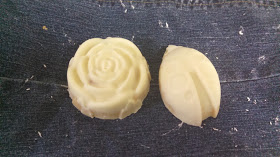
Super-fating soap or discounting lye, are two of the best ways to tailor your soap to meet your needs. Got oily skin, dry skin, the answer is right in your kitchen not in the detergents. Would you want to know what FDA, the U.S. Food and Drug Administration says about lye soap? Read more…
According to the FDA, a true soap is made of made with oils and lye (Check FDA Soap: faqs). Sodium Hydroxide is used to make hard soap and Potassium Hydroxide for soft and liquid soap. When lye is dissolved in water it is generally referred to as “lye” or “lye solution”. When properly made, lye is NOT present in the final soap. “Soap: FAQS”. FDA U.S. Food and Drug Administration. FDA. 13 Jun 2013. 20 Dec. 2014.
Lye calculator is used to calculate the quantity by weigh of soap ingredients. Those calculators have a margin of error and numbers are rounded when using scale. As homemade soap is not tested in a laboratory to analyze the final content of the finished products, it is safer to apply a lye discount when formulating the soap recipe. Generally, a lye discount can range from 3% to 10 % with an average 5%. When applying a lye discount, the soap will have excess oils in the finished products which contribute to its moisturizing quality. Similarly, the lye can be calculated with 0% discount. As the soap mixture reaches trace, few tbsp. of extra oil is added. It is called super fatting.
In brief, discounting is decreasing lye in the recipe and super fatting is adding more oil at the end.
When should you discount lye and when should you super fat?
It depends on your expectation from the soap.
When using regular ingredients with no additives such as milk powder or honey or herbs, it is easier to discount the lye.
When additives will be added at trace and will need to be mixed in some oil before adding to the whole soap mixture at trace, then extra oil can be used for that matter to super fat. It easier however, to apply a lye discount and reserve some oil from the batch before adding the lye solution to the oil. The reserve oil could then be used to mix the additives.
When using the additive to marble the soap rather than mixing with the whole batch at trace, it is better to apply a lye discount AND super fat to avoid having a part of the soap with excess lye and a part of it with super fat. Check we did it in our recipes: Coconut & Cocoa Butter Soap Bar and Make Me Feel Special Soap Bar.
When super fatting, specialty oil can be used such as Shea Butter or Cocoa Butter as they are loaded with skin care properties good to preserve in the soap. Therefore, when any of these oils are included in the ingredients, it is preferable to save some of it to super fat to avoid exposing it to the whole saponification process. When combining lye and oils, oils are degraded into free fatty acids to react with the alkalis in our case lye to form soap. During that process glycerin is produced as well. Glycerin is very moisturizing and excess quality oil is a plus.
To conclude, when making soap, lye can be discounted or the mixture can be super fatted. When super fatting, use the oil in the ingredients that has the properties worth having in excess in your final soap. For oily skin, do not super fat your soap rather discount the lye gently to about 5%.
Happy Soaping!

Leave a Comment